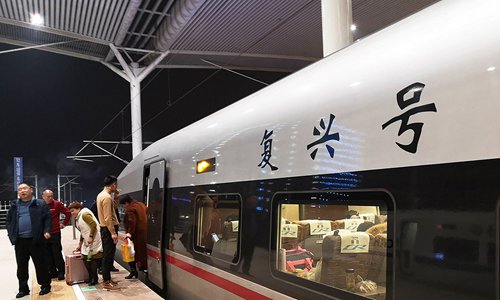HOME >> BUSINESS
IPO prospectus reveals profitability of Chinese railway operators
By Wang Bozun Source:Global Times Published: 2019/10/30 20:27:51

A view of a Fuxing bullet train in Shanghai. File Photo: VCG
Profitability figures for China's railway operator have been released for the first time as part of an IPO prospectus, and the documents show that two-thirds of the group's units are operating in the red.
A company under the China State Railway Group (CSRG) that operates the Beijing-Shanghai section of the national high-speed railway network is in the process of applying for an IPO. As part of the filing, the division released profitability data for itself and other subsidiaries of the CSRG, including 18 railway branches.
According to its prospectus, which was published by the China Securities Regulatory Commission on Friday, six of the 18 railway branches made a net profit in 2018. The branch in Taiyuan, capital of North China's Shanxi Province, performed the best with a net profit of 9.6 billion yuan ($1.36 billion). The Guangzhou-Hong Kong High-speed Railway made a net profit of 565 million yuan in 2018, and 426 million yuan in the first half of this year.
Beijing-Shanghai High Speed Railway Co reported a net profit of 9.51 billion yuan in the first nine months of the year.
The other 12 branches lost money in 2018. Most reported losses of less than 5 billion yuan, such as the Qinghai-Tibet bureau, which reported a loss of 2.3 billion.
According to the prospectus, most of the profitable bureaus are located in more developed and highly populated areas such as Shanghai branch near the Yangtze River Delta region, while those that reported losses are less-populated regions in the west of China.
Tian Yun, director of the China Society of Macroeconomics Research Center, told the Global Times that regional differences are the main cause of the different profitability, and it's normal for bureaus close to the east to do better than those in the west.
"The Beijing-Shanghai railway connects the two most developed regions in China - the Beijing-Tianjin-Hebei region and Yangtze River Delta region. With high levels of capacity and demand, it is natural for it to have a better performance," Tian said.
But Tian emphasized that high-quality service is also a consideration. For example, the Shanghai branch's service is good. By contrast, he said that branch in the west need to improve their business philosophy, quality of personnel and services.
Tian noted that railway projects in some undeveloped areas such as those under the Qinghai-Tibet bureau are more like public welfare programs. Given the low population levels in these areas, it is unfair to expect them to do as well as those in the east. In the long run, the economic benefits of those projects will actually exceed the original investment.
To improve the Chinese railway operator's performance, Tian suggested allowing private capital into profitable railway projects.
At the same time, the country should keep investing state funds in the public-welfare-like projects in the west, which will help the national railway system achieve greater financial balance.
"If in the future we can attract private investment into lucrative railway projects in a market-oriented way, then we can maintain a more sustainable financial balance in the railway sector."
Posted in: INDUSTRIES,MARKETS